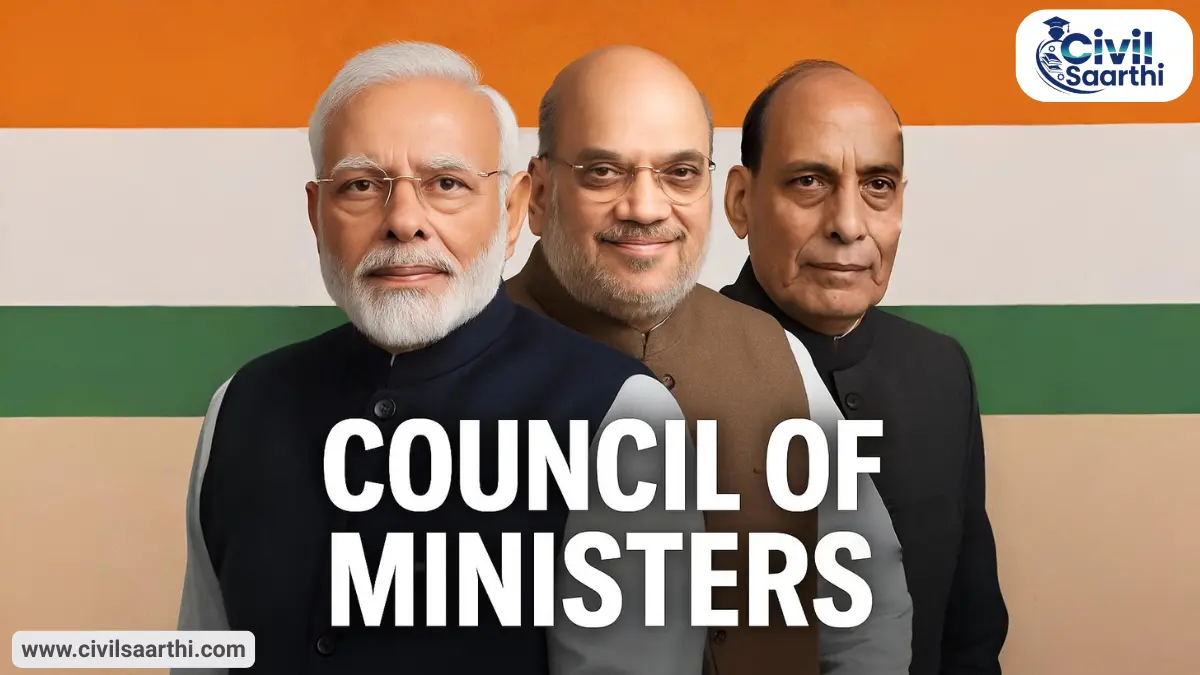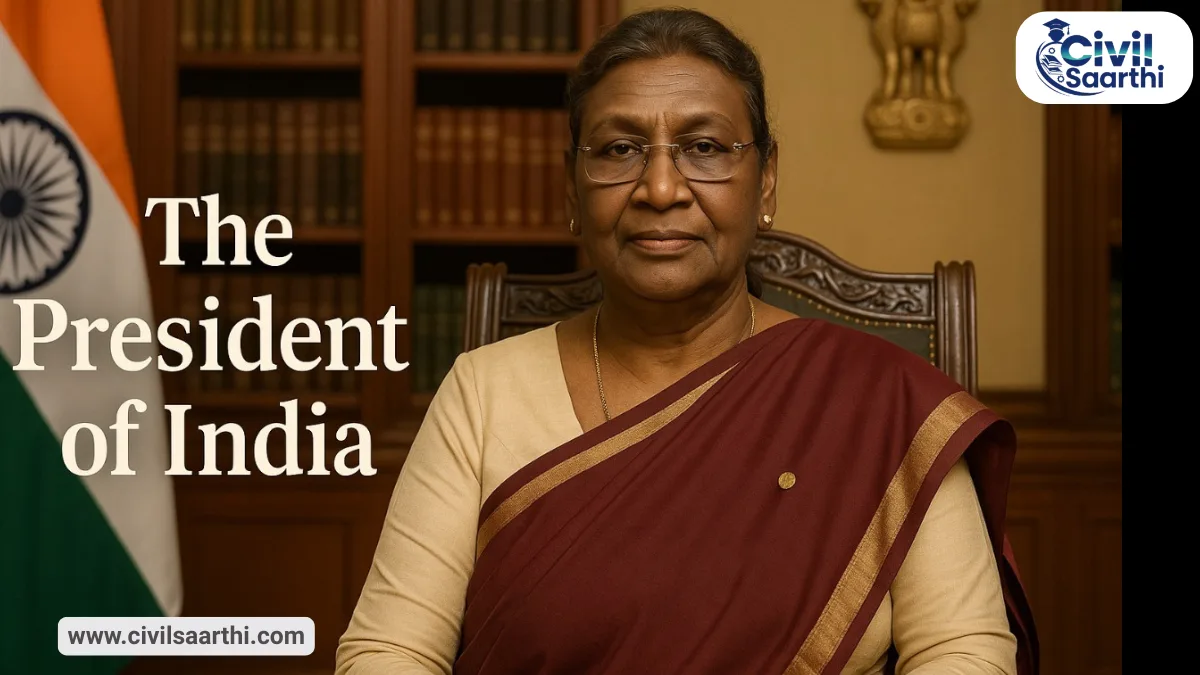Council of Ministers Introduction
The Council of Ministers (CoM) is the real executive in India, functioning under the Westminster model of parliamentary democracy. The President is the nominal executive, while the CoM, headed by the Prime Minister, exercises actual power.
The CoM is collectively responsible to the Lok Sabha.
It functions under Articles 74 to 78 of the Constitution.
Aids and advises the President in the discharge of his constitutional duties.
Its functioning is governed by both written constitutional provisions and unwritten parliamentary conventions.
Constitutional Provisions Related to Council of Ministers (CoM)
The Constitution provides the framework for the formation, functioning, and powers of the Council of Ministers.
| Article | Detailed Provision |
|---|---|
| Article 74 | (1) There shall be a Council of Ministers with the Prime Minister at the head to aid and advise the President. (2) The President shall act in accordance with such advice, but may once require it to be reconsidered. |
| Article 75 | (1) The PM shall be appointed by the President and other ministers shall be appointed on PM’s advice. (2) Ministers hold office during the pleasure of the President. (3) The CoM shall be collectively responsible to the Lok Sabha. (4) A minister must become a member of Parliament within six months. (5) Salaries are determined by Parliament. |
| Article 76 | Establishes the office of the Attorney General of India, the highest law officer who advises the Government of India on legal matters. |
| Article 77 | All executive actions of the Government of India shall be expressed in the name of the President. Rules to be made for the convenient transaction of business. |
| Article 78 | Duties of the PM to communicate to the President all decisions of the CoM, and furnish such information as the President may require. |
| Article 88 | Ministers have the right to speak and participate in Parliament and its committees, even if they are not members, but cannot vote unless elected to the House. |
The CoM comprises various categories of ministers, forming a hierarchical structure to ensure division of work and responsibility.
Prime Minister: Leader of the CoM and head of government.
Cabinet Ministers: Senior-most ministers who head important ministries and participate in Cabinet decisions.
Ministers of State (Independent Charge): Junior ministers handling ministries independently without being under a Cabinet Minister.
Ministers of State: Assist Cabinet Ministers in handling complex ministries or departments.
91st Constitutional Amendment Act, 2003: Limits the total number of ministers to 15% of the strength of the Lok Sabha.
Oath and Salary of Ministers
The Constitution mandates that ministers must take an oath before assuming office and that their salaries are determined by Parliament.
Oath of Office (3rd Schedule): To bear true faith and allegiance to the Constitution, and faithfully discharge duties.
Oath of Secrecy: Not to reveal matters brought under secrecy during tenure.
Administered by: The President of India.
Salary: As per Article 75(6), ministers’ salaries are decided by Parliament through laws like the Salaries and Allowances of Ministers Act, 1952.
Other Perks: Include government accommodation, travel allowances, staff, and security.
Functions and Responsibilities of the CoM
The CoM plays a critical role in the daily functioning of the Union Government and is responsible for legislative, administrative, and financial duties.
Executive: Administers day-to-day governance and ensures implementation of policies.
Legislative: Introduces bills, supports government business in Parliament, issues ordinances under Article 123.
Financial: Frames the Union Budget, controls expenditure, and sets economic policy.
Policy: Sets national priorities and policies through Cabinet decisions.
Foreign Affairs and Defence: Handles treaties, military operations, and diplomatic engagements.
Judicial Appointments: Advises President on appointments of judges, CAG, Election Commissioners, etc.
This principle ensures the entire Council is accountable as a single unit to the Lok Sabha. It is a constitutional obligation that upholds democratic governance.
Based on Article 75(3): The CoM is collectively responsible to the Lok Sabha.
If a no-confidence motion is passed, the entire CoM (including PM) must resign.
Promotes internal unity and ensures shared accountability.
Individual Ministerial Responsibility
While collective responsibility ensures unity, individual responsibility ensures personal accountability of ministers for their departments.
Rooted in parliamentary conventions, not explicitly stated in the Constitution.
A minister can be questioned in Parliament or removed due to poor performance or misconduct.
The Prime Minister can advise the President to dismiss a minister.
Allows targeted accountability without bringing down the entire government.
Cabinet vs Council of Ministers Key Differences
Both are part of the executive, the Cabinet is a smaller, more powerful subset of the CoM. It includes the senior-most ministers and is primarily responsible for policy decisions and government strategy.
| Aspect | Cabinet | Council of Ministers (CoM) |
|---|---|---|
| Size | Smaller core group | Larger group (includes all ministers) |
| Composition | Senior-most ministers | Cabinet + MoS + Deputy Ministers |
| Meetings | Regularly convened | Rarely meets collectively |
| Decision-making | Key policymaking body | Implements Cabinet decisions |
| Constitutional Mention | Not explicitly mentioned | Explicitly mentioned in Article 74, 75 |
| Powers | Decides major national policies | Assists in execution and support functions |
Role of the Prime Minister in CoM
The Prime Minister is the pivotal figure in the functioning of the CoM and central to the government’s working.
Appointed under Article 75(1) by the President.
Coordinates all functions of government.
Leads Cabinet meetings and decisions.
Allocates and reshuffles ministerial portfolios.
Communicates Cabinet decisions to the President (as per Article 78).
Emergency Functions of CoM
In times of constitutional emergency or crisis, the CoM becomes the principal advisor to the President in invoking special powers.
Article 352: Recommends National Emergency.
Article 356: Advises President’s Rule in states.
Article 360: Recommends Financial Emergency.
CoM’s advice is essential in revoking or continuing emergencies.
Judicial Scrutiny and Legal Immunity
While the CoM enjoys confidentiality in its internal decision-making, it is not beyond the purview of judicial review.
Article 74(2): The court cannot question the advice given to the President.
However, actions based on such advice (e.g., ordinances, dismissals) can be reviewed by the judiciary.
Maintains balance between executive privilege and rule of law.
Comparison with UK Cabinet System
India’s Council of Ministers is deeply influenced by the British Westminster model, but it has been modified to suit India’s written Constitution, federal structure, and judicially reviewable framework. While both systems follow a parliamentary executive model, there are key differences in structure, accountability, and conventions.
Origin of Indian CoM System
The Indian parliamentary system is modeled on the British Westminster form of government.
Both systems uphold collective responsibility, the primacy of the Prime Minister, and Cabinet supremacy in policymaking.
However, unlike the UK, India has a written Constitution, and its executive powers are constitutionally limited and justiciable.
Key Differences Between Indian and UK Cabinet Systems
| Aspect | India | United Kingdom |
|---|---|---|
| Legal Basis | Based on a written Constitution (Articles 74–78). | Based on conventions and customs; no written constitution. |
| Head of State | President (nominal head), bound by CoM’s advice. | King/Queen (ceremonial monarch), acts on advice of ministers. |
| Removal of Ministers | Ministers serve “during the pleasure of the President” but effectively on PM’s advice. | Ministers hold office at the pleasure of the Prime Minister; Monarch has no real say. |
| Collective Responsibility | Enshrined in Article 75(3); legally enforceable. | Based on unwritten conventions; politically binding, not legally. |
| Judicial Review | Advice/actions of CoM are subject to judicial scrutiny (e.g., ordinances, emergency advice). | Courts generally do not intervene in Cabinet decisions. |
| Parliamentary Sovereignty | Constitution is supreme, not Parliament. | Parliament is sovereign; no written constitutional limits. |
| Ordinance Power | President promulgates ordinances under Article 123 on CoM’s advice. | No equivalent; UK government uses parliamentary majority for urgent legislation. |
| Cabinet Secrecy | Protected under Article 74(2); decisions not disclosed publicly. | Cabinet decisions are also secret but based on traditions, not law. |
Committees’ Recommendations on Reforming the Council of Ministers (CoM)
Various expert commissions have recommended reforms to improve the efficiency, accountability, and coordination of the Council of Ministers in India. These suggestions aim to strengthen centre-state relations, ministerial performance, and ensure constitutional propriety.
1. Sarkaria Commission (1983-1988)
Formed to review Centre–State relations, the Commission made crucial recommendations affecting the CoM:
Limit the size of CoM to ensure collective responsibility and functional coherence.
Recommended a Code of Conduct for Ministers to ensure ethical governance and transparency.
Stressed that the Governor should appoint the Chief Minister only based on clear majority support.
Advocated greater decentralization and delineation of functions between Cabinet and MoS (Ministers of State).
2. Punchhi Commission (2007-2010)
Set up to revisit federal issues post-liberalization, the commission refined Sarkaria’s suggestions:
Called for a constitutional limit on the size of CoM at the state level (on the lines of the 91st Amendment at the Centre).
Recommended a fixed tenure of Chief Ministers for ensuring policy continuity.
Emphasized on strengthening the role of Cabinet Committees for better intra-ministerial coordination.
Advocated greater clarity between Cabinet decisions and executive orders to avoid misuse or confusion.
3. 2nd Administrative Reforms Commission (2nd ARC)
In its 13th Report titled “Organisational Structure of Government of India”, it made direct observations on CoM functioning:
Recommended clear job descriptions for each minister to avoid overlapping responsibilities.
Proposed Performance Evaluation Framework for ministers, similar to bureaucrats.
Suggested merging smaller ministries to reduce fragmentation and ensure accountability.
Urged limiting the number of ministries for administrative efficiency and fiscal prudence.
Recommended that Cabinet Secretariat should play a stronger role in inter-ministerial coordination.
Despite being the central decision-making body, the CoM faces operational and structural criticisms.
Excessive Prime Ministerial dominance, especially under strong majority governments.
Political compromises in coalition governments may weaken decision-making.
Lack of transparency in appointments and decisions.
Limited independence of Ministers of State and junior ministers.
Significance of the Council of Ministers
The CoM is the backbone of India’s democratic machinery. It ensures that governance reflects the will of the people and is carried out by their elected representatives.
Ensures real executive power rests with the accountable body.
Maintains link between legislature and executive.
Enables efficient and coordinated administration.
Upholds principles of constitutionalism and accountability.
Important Doctrines & Judicial Interpretations
S. R. Bommai Case (1994): Clarified that the advice of CoM for President’s Rule can be reviewed judicially.
Ram Jawaya Kapur Case (1955): Declared the President as the constitutional head; real executive authority lies with ministers.
Shamsher Singh v. State of Punjab (1974): Reaffirmed that the President exercises powers only on the advice of CoM.
Way Forward
To strengthen the efficiency and accountability of the Council of Ministers, reforms must focus on internal balance, transparency, and democratic functioning.
Codify conventions on ministerial responsibility for clarity and consistency.
Define roles of Ministers of State to reduce over-centralization in the Cabinet.
Institutionalize performance reviews to assess ministerial effectiveness.
Promote transparency in Cabinet decisions while safeguarding confidentiality.
Ensure training and orientation for newly appointed ministers in governance and constitutional duties.
Council of Ministers FAQs
What is the constitutional article that defines the CoM?
Article 74 and Article 75 lay down the basis of the Council of Ministers in the Constitution.
Who appoints the Council of Ministers?
The President appoints ministers on the advice of the Prime Minister.
What is collective responsibility in the Council of Ministers Polity Note?
It means the entire CoM is responsible to the Lok Sabha for its decisions.
Can a Minister be removed without dissolving the whole CoM?
Yes, under the principle of individual responsibility, a minister can be removed.
Is the Cabinet mentioned in the Constitution?
No, the term ‘Cabinet’ is not explicitly mentioned in the Constitution.
What is the difference between CoM and Cabinet?
The Cabinet is a smaller, more powerful subset of the CoM involved in key decisions.
What happens if the CoM loses majority in Lok Sabha?
The entire Council of Ministers must resign, as per the collective responsibility principle.







